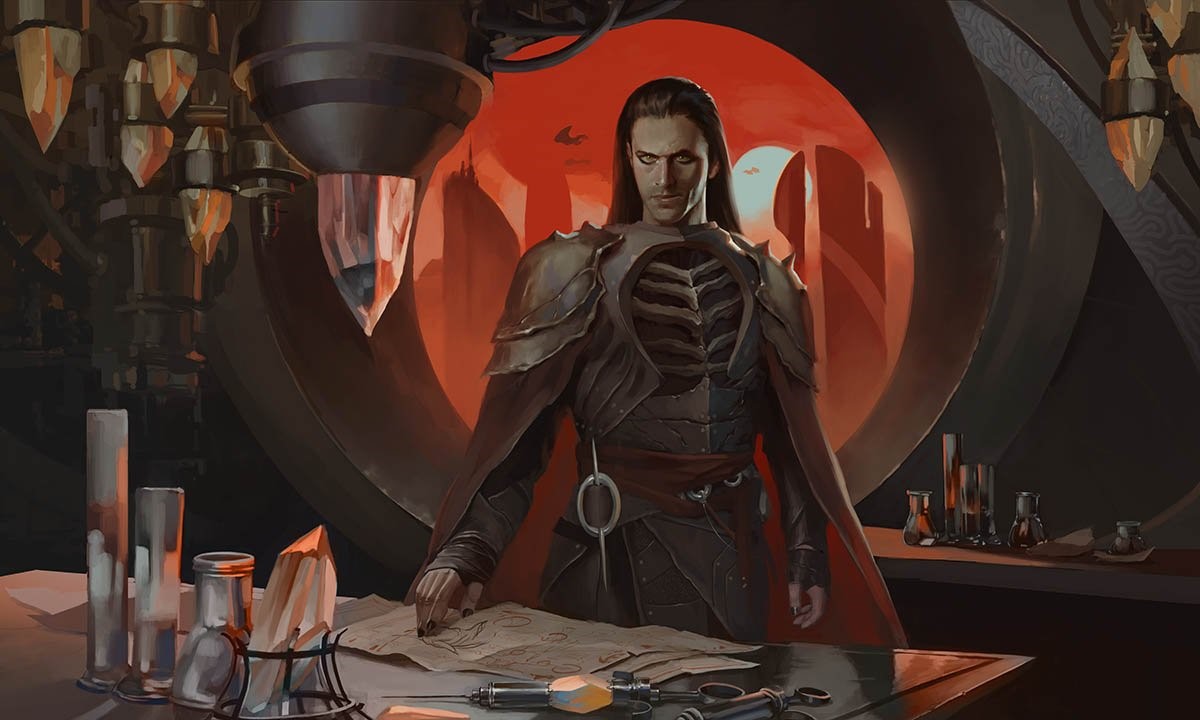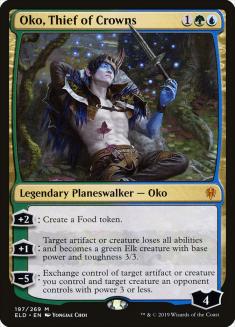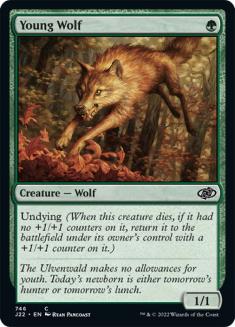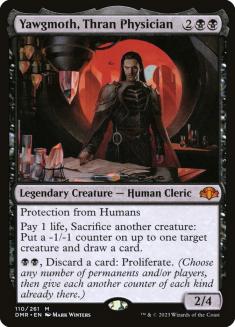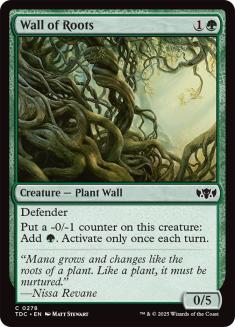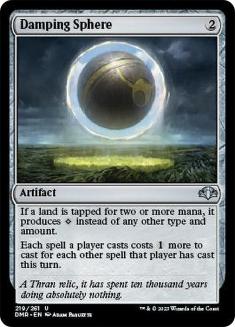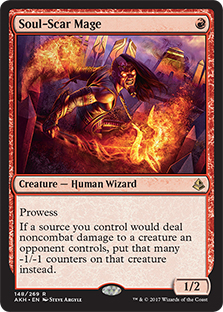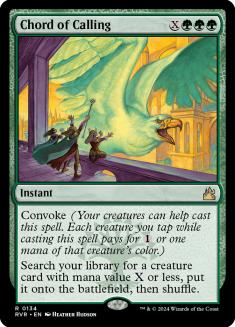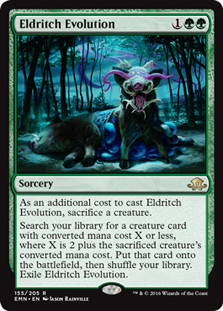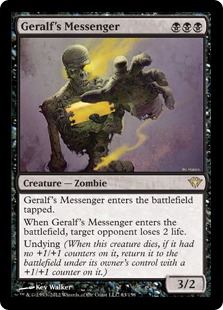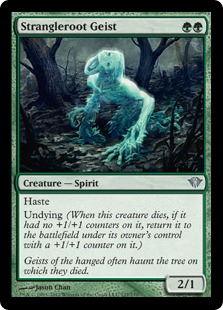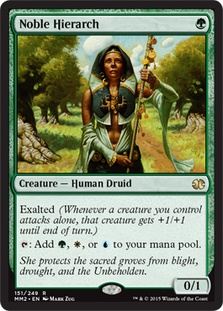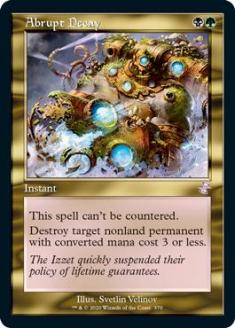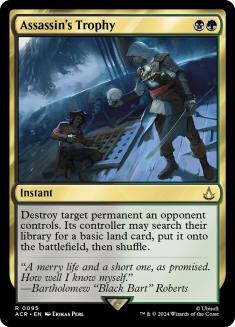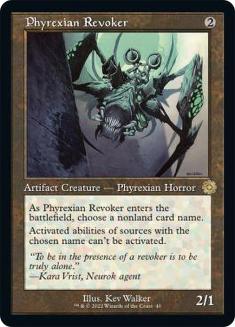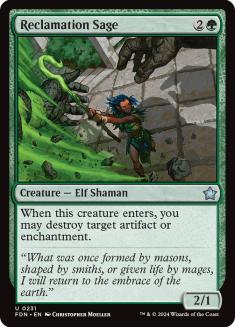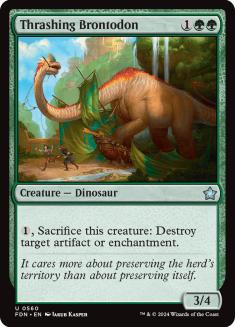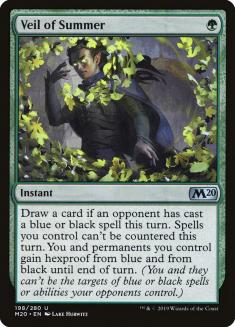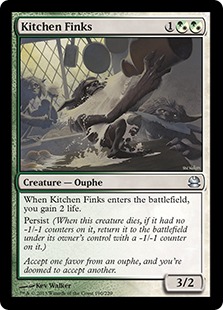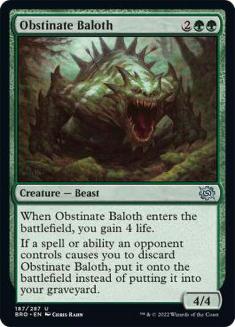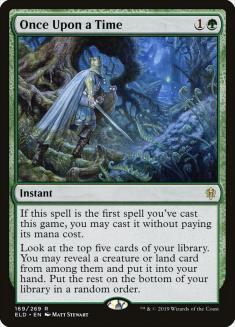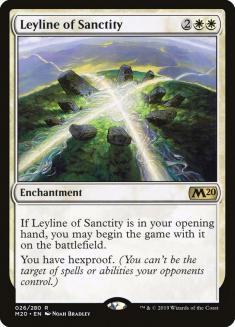They finally did it!
Good riddance, Oko, and don’t let the door hit you on your way out! Take your dumb little trinkets with you! So long! Farewell! Sayonara!
Just like the Phyrexian invasion of Magic yesteryear, we kept our heads just low enough to dodge suspicion until it was time to strike. Can you believe those fools didn’t ban the true terror of Modern?
Look at the power level of this beast. It’s a 1/1 for one, a 2/2 for one, and 1/3rd of a Yawgmoth’s Bargain all at once!
Really, though, can you believe another card from Modern Horizons turned out to be great? Who would have predicted another mythic with a wall of text would lead to such a story? I’m sure our good friend Urza isn’t happy. Poor soul lost a few good friends to the bannings and lost a lot of style points by having to lose to his enemy Yawgmoth.
If you don’t understand the basic concept of the deck, check out the deck tech I did with Nick Miller last weekend where I went over Golgari Yawgmoth and how the combo works.
Why You Should Play Golgari Yawgmoth
Do you enjoy game actions? Do you enjoy drawing cards? Do you enjoy feeling really smart? If any of these apply, then my good friend Yawg may be for you!
I’ve had a lot of people ask me why they should play this over more stock creature combo decks like Devoted Devastation. The biggest reason is our natural resiliency and strength beyond our combo gameplan. Most creature combo decks are weak to heavy spot removal and some pinpoint interaction on the important creatures, but not this one.
While Yawgmoth, Thran Physician himself tends to be fragile, Lightning Bolt and Fatal Push both do little to interact with the other combo creatures and Path to Exile ramps this already mana-hungry deck, leading to you actually having a great matchup against decks such as Jund and Grixis Death’s Shadow and a reasonable matchup against Azorius-based interactive decks. While being able to grind through removal, you still have a consistent Turn 4 kill with the potential for a Turn 3 with a great hand, which gives you a solid game against the noninteractive decks in the format.
This deck is one of the hardest I’ve had the pleasure of playing. There are many situations where you have outs to play to and knowing just which ones you can try for is the difference between winning and losing a match. A slight missequence can lead to you being unable to cast all of your combo pieces in time, but it’s the most rewarding deck I’ve ever played, and having gotten enough games in will pay off for you in the end, giving you an amazing feeling of control and power compared to what everyone else is doing.
Tips and Tricks
- Your life total is valuable. You can’t combo from one life, so do everything you can to try to at least stay at two. Don’t fetch and shock if you don’t think you have to, as keeping your life above your opponent’s keeps more kills open in addition to every life you have possibly turning into one card at a later time.
- Be mindful of Wall of Roots. It’s the most powerful mana source in the deck and it’s often correct to use it to cast spells in turns you might draw cards just in case you hit an instant and want to use it on both turns. It can be correct to not cast your one-drop on Turn 1 if you have a Wall of Roots that can cast it on Turn 2, instead opting to play a tapped land. Be open to the idea of shrinking your own Wall of Roots when unnecessary to play to your own Blood Artist or being able to block and kill it to stop lifelink creatures.
- Sometimes not trying to win is the best play. People will often hold up removal for Yawgmoth and will have to wait for you to start to sacrifice creatures before they can attempt to kill him. If you just leave the combo on the battlefield and don’t start sacrificing any creatures, your opponent can be forced to continually leave up the removal or die, putting a big strain on them. Remember, you can always go off in response to anything they could use to interact with you anyway.
- Damping Sphere is the most awkward card in the deck. Twilight Mire awkwardly enough taps for two mana when being used as a colored source and can be turned off by your own artifact, so be careful not to lock yourself out if you can avoid it. This drawback is annoying, but it’s often much better for us to be unable to cast a spell than it is for our Mono-Green Tron, Amulet Titan, or Gifts Storm opponent to be doing their best thing.
- Soul-Scar Mage can be awkward against undying creatures, but often only in the form of Lava Dart. If your opponent controls a Soul-Scar Mage and Lightning Bolts your Geralf’s Messenger that has a +1/+1 counter on it, your Messenger will die before the two counter types remove each other.
Sideboarding
This is the hardest deck I’ve ever had to sideboard with and is the part I feel the least confident in. In general it’s okay to shave on the tutors, as drawing too many of those is often a way to lose, even when you’re sideboarding in great tutor targets. In matchups that are all about speed and matchups that don’t play a lot of counterspells, I often shave more copies of Chord of Calling than Eldritch Evolution.
The opposite is true against heavy-interaction decks or against decks with counterspells. Never cut the Blood Artist, no matter how bad you think it may be in the matchup. I’ve regretted every single time I’ve sideboarded it out and have learned my lesson. Against matchups where your mana is taxed, I find is okay to sideboard out a single copy of Once Upon a Time, as the first is very good but the deck is already redundant and drawing multiples can slow you down too much. Additionally, never cut Once Upon a Time against people who have sideboarded in Grafdigger’s Cage, as it’s a crucial part of finding your Reclamation Sage or Thrashing Brontodon.
I’ve been able to cut two undying creatures without feeling like I’ve had a hard time getting one onto the battlefield. This leads to me cutting Geralf’s Messenger in matchups where blocking is most important, Strangleroot Geist in matchups where the combo is most important, and Young Wolf in matchups where card quality is most important. Against those same matchups where I cut Young Wolf, I often find myself shaving on a mana creature or two to try to keep my overall card quality higher, as it can be difficult to get something together when they counter or make you discard your copy of Yawgmoth or your few good threats.
VS Eldrazi Tron
Out:
In:
Damping Sphere hurts us too much to be worth bringing in. Try and save Assassin’s Trophy and Abrupt Decay for Grafdigger’s Cages or Pithing Needles. Karn may not be able to lock us out with Mycosynth Lattice anymore but it still grabs those far more annoying artifacts.
VS Death’s Shadow variants
Out:
In:
If you know your opponent doesn’t have any interactive artifacts or enchantments, I wouldn’t sideboard in the creatures but I tend to prefer I have the option to tutor for them just in case. Don’t start attacking until you think you’re going to win soon, as Death’s Shadow plus Temur Battle Rage has been the only real way I’ve lost the matchup.
VS Burn
Out:
In:
The combo is not the main plan in this matchup. Drawing multiple Yawgmoths is a death sentence and they’re unnecessary to win the game. Geralf’s Messenger is an awful blocker and often forces us to fetch Overgrown Tomb to cast early. Due to cutting Geralf’s Messenger, we’re often Eldritch Evolutioning for a creature that costs four mana. leading to us playing Obstinate Baloth over Thragtusk (Cavalier of Night is often a knockout blow if you do get to the point where it is tutorable). Kitchen Finks doesn’t combo, but is a solid source of lifegain that can be quickly tutored for when compared to the more expensive options.
VS Azorius-based Control
Out:
In:
Eldritch Evolution is bad against counterspells. Try to get value Yawgmoths when you can and don’t go out of your way to combo if it will cost too many resources. Kill most planeswalkers whenever possible, and if they’re playing Supreme Verdict, the matchup shouldn’t be that hard. If they’re playing Terminus, however, you’re in a lot of trouble.
VS TitanShift
Out:
In:
Anger of the Gods is your biggest fear in this matchup. You’re slightly faster than they are and their Lightning Bolts don’t do enough to slow you down. As usual, the answers are brought in just in case.
VS Amulet Titan
Out:
In:
You have almost no game against their fastest starts but will beat most of their fair starts. Yawgmoth is great at keeping Azusa, Lost but Seeking and Sakura-Tribe Scout off the battlefield. Don’t let them get you with a Bojuka Bog off a Scout at instant speed.
Beating Golgari Yawgmoth
Faster combo decks that don’t really on creatures that easily die to Yawgmoth are a great way to combat this deck. Gifts Storm has been consistently problematic even with more sideboard hate, as Remand is a powerful tool against the deck. Pressuring the Yawgmoth deck’s life total can put it in a tough position of being unable to draw enough cards to find its combo pieces or be unable to win with the Geralf’s Messenger kill. Prowess falls into both of these camps and can be very difficult to beat, as Golgari Yawgmoth doesn’t play enough removal to answer the early threats before our life total is too low to use Yawgmoth as an answer.
Grafdigger’s Cage is the best hate card against the deck as it both turns off the combo and the tutor effects that are often used to beat the hate. Leyline of the Void stops undying, but doesn’t stop the tutor effects. I’d bring Leyline in if you have it, but don’t mulligan to it or expect it to win the game on its own. Casting the Leyline the natural way against Yawgmoth isn’t the worst to happen either.
Leyline of Sanctity stops the combo from outright winning and can stop some of the sideboard hate like Thoughtseize, yet is easy to destroy and is only a small stopgap against the deck. Only sideboard this in if its a racing matchup that’s forcing the deck to combo quickly, like against Ad Nauseam or Selesnya Hexproof. Pithing Needle effects can turn off Yawgmoth but don’t stop the rest of the creature plan. If your deck has the ability to fight off the creatures or is just looking to slow the combo down a turn or two, Pithing Needle and its ilk are quality cards to sideboard in.
Veil of Summer is not actually good against the deck and you shouldn’t be sideboarding it in against the list I was playing. My list played very little that actually targeted my opponents or their creatures, and using it to stop a single Yawgmoth activation on one of your creatures isn’t often worth having to hold up the mana. It can stop the combo from killing for a moment, but it gets right back into the swing of things on the next upkeep. There are exceptions and I can believe sideboarding it in to protect some creature combos like Devoted Druid might be worth it, though I’m still not sure that’s even good.
Updates
Modern is changing, but I imagine much of this deck will not. The core cards are pretty set in stone outside of some major deck overhaul and losing Oko is good for this deck, as it was one of the best maindeck pieces of interaction people were playing. If graveyard or burn decks become more popular, a copy of Scavenging Ooze can be added to the deck as a Game 1 tutor target.
Leyline of the Void is one the greatest graveyard hate spells of all time and can be put in the sideboard to help fight both Dredge and the mirror. Another large lifegain source such as Thragtusk could be put into the sideboard if an increase of red worries us. Tom Ross came up with the idea of Stain the Mind as a card that helps shore up some of the noninteractive combo deck matchups. I like that idea a lot, even though I haven’t gotten to test it.
More access to artifact destruction may be necessary if the metagame shifts to a larger number of Grafdigger’s Cages as your tutors no longer count as answers. Nothing in the sideboard is sacred and the whole sideboard plan could be revamped. Be willing to swap things out for your expected metagame, as that’s one of the biggest strengths of the Chord of Calling / Eldritch Evolution decks.
The manabase for the deck isn’t flawless, but another color could be added thanks to Birds of Paradise and Noble Hierarch. Cards such as Knight of Autumn or Eidolon of Rhetoric are great tutor targets than can be gained from minor land changes that could help shore up the Gifts Storm and Burn matchups. People in the past have played blue for access to Neoform as an additional tutor to help set up the combo, but I have only had the deck in my hands for a few weeks, so I’m sure the number of ideas that could be put into this shell go far past what I’ve had the time to try. Yawgmoth is an amazing engine and can support so many ideas and experiments, but that’s to be expected from the Father of Machines. Just don’t get too carried away and start creating a monstrous army by mistake!
Good luck out there in our refreshed Modern. May you find Phyrexia’s love in all its forms. May we all become one.

